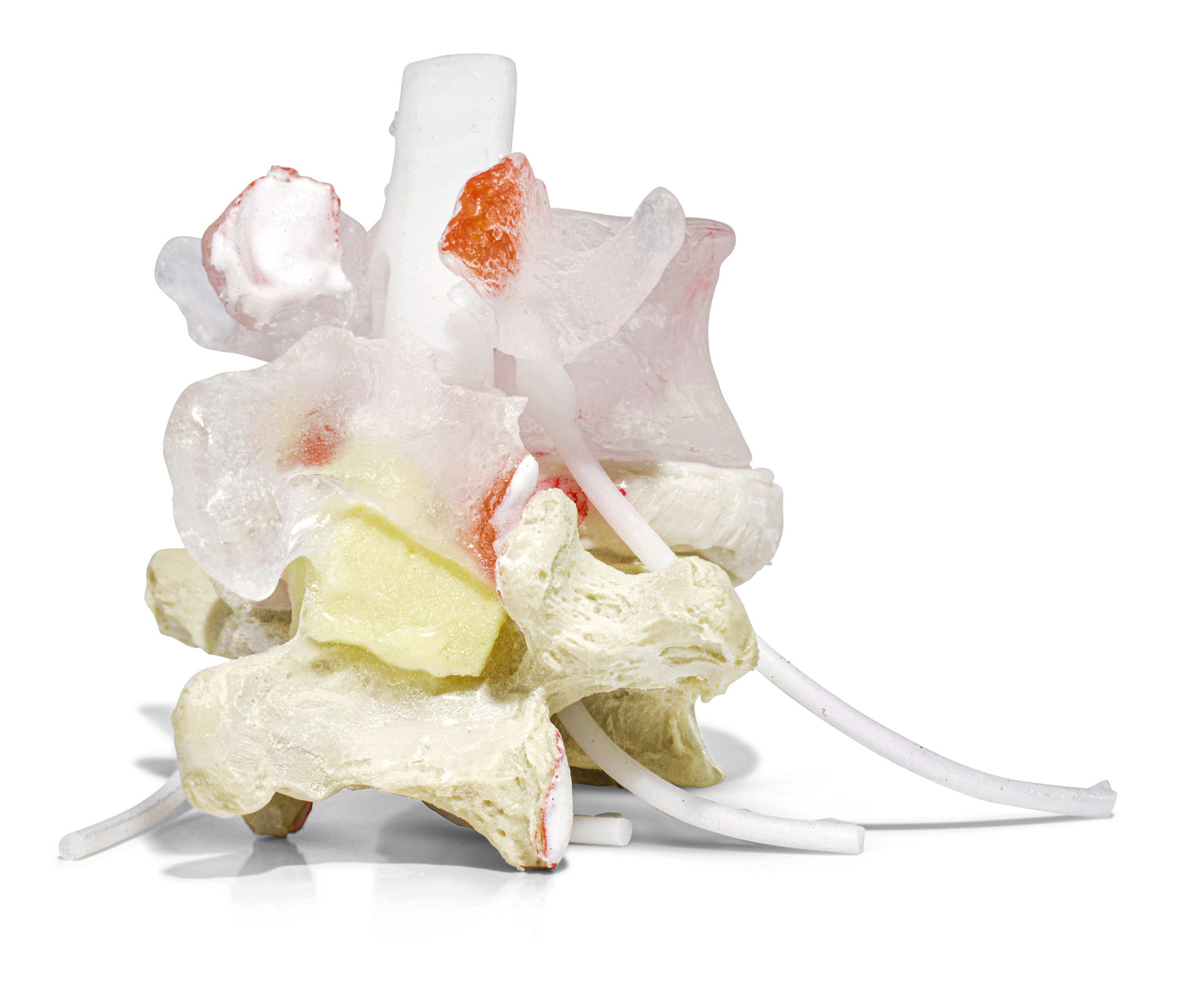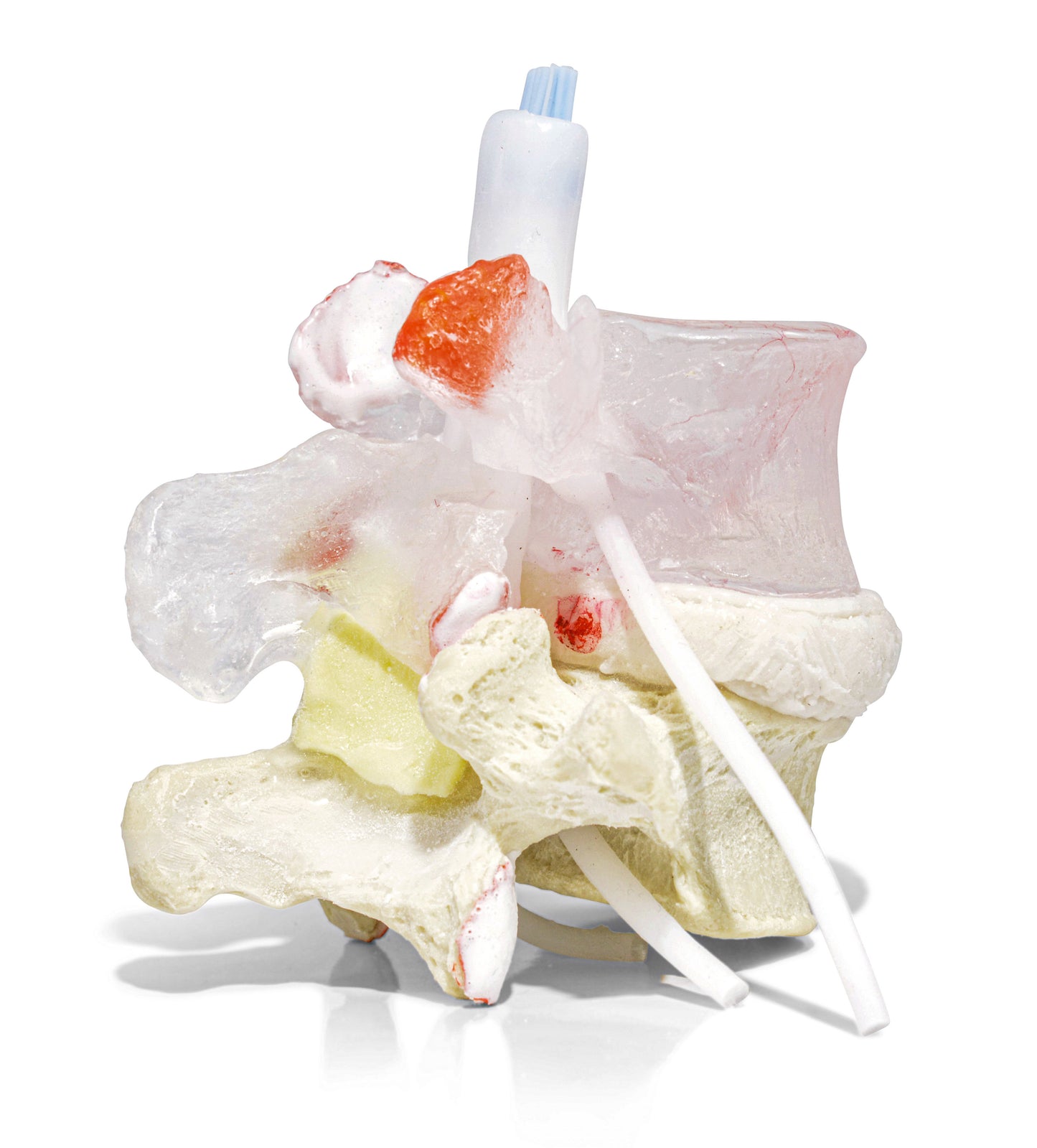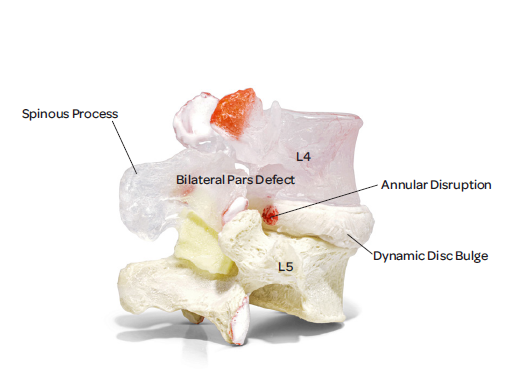SKU:EA-SpLxH
Anatomical spine model with spondylolysis and spondylolisthesis
Anatomical spine model with spondylolysis and spondylolisthesis
Out of stock
this product is made to order. To place an order please call or write us.Couldn't load pickup availability
This dynamic spinal joint model consists of 2 lumbar vertebrae, an intermediate disc (disc) and nerves. As something extraordinary, the upper lumbar vertebra is transparent. This easy-to-learn and stylish design offers additional and cutting-edge features such as visualization of blood vessels and lesions within the transparent lumbar vertebra interior as well as intervertebral disc architecture and lesions within it.
The model can primarily be used for learning about spondylolysis and spondylolisthesis in the lower back, but it offers much more.
The following characteristics should be highlighted (read more about these in the text below):
- Spondylolysis (fracture of both vertebral arches on the model)
- Spondylolisthesis (the "slip" can be manually demonstrated by moving the model)
- A herniated disc
- Other damage, such as a break in an end plate
- A transparent lumbar vertebra that offers viewing of detailed anatomy
- An exceptional opportunity for movement in the joints
- Realistic tissue casting
Both in terms of size and weight, the model corresponds to 2 lumbar vertebrae in an adult person. The model is not designed to be disassembled. It is possible to purchase a stand.
NB: This model is part of our unique series of dynamic and innovative spine models. The models are handmade in Canada, cast after human vertebrae and can demonstrate all the movements in the joints of the back. The materials are extremely lifelike in very high quality with components from the USA (and therefore not China etc.).
The models are developed with a focus on dynamics, interaction and simplicity in their use. The purpose is that the professional with the spinal joint model in hand can accurately and quickly explain the mechanisms of degenerative changes in the spine as well as their relationship to pain, function and the biomechanics of the spine. Furthermore, the models are developed to be able to withstand active and repeated use.
Anatomical features
Anatomical features
Anatomically, the model shows 2 lumbar vertebrae (L4-L5) and therefore the two most important joint types in the spinal column, which are the symphysis (disc/disc) between 2 vertebral bodies and the facet joints, which are sliding joints between the vertebrae's pivots. Overall, the bone quality is extremely good, and therefore, for example, knots and depressions in the bone tissue are clearly visible.
The model was developed with a focus on spondylolysis, which is a fracture in part of a vertebra. On this model, fractures are seen in both vertebral arches (but not in the facet joints). The model has also been developed to demonstrate spondylolisthesis, which means that one vertebral body slips forward in relation to another vertebral body in the spine. Spondylolysis can cause spondylolisthesis. The possibility of demonstrating spondylolisthesis is described below, where movement of the model is described.
L4 (the model's "top" lumbar vertebra) is transparent as part of the learner-friendly design. The model and in particular the transparency of L4 offers possible to see the following:
The special shape of the tape disc
A "radial" and "circumferential" tear in the disc's connective tissue ring
A simulated endplate fracture at the top of L5
Openings (pores) in black color in the end plate at the top of L5
Blood vessels in L4 (in the vertebral body)
Subchondral blood vessels in joints
Corpse. flavum
Other cartilage damage
The model is delivered with a nerve bundle (cauda equina) in the vertebral canal.
On this model, the nerve bundle is complete because it shows a mass of loose spinal nerve roots in blue surrounded by a whitish membrane, which is also translucent (but not transparent). This visual and educational construction thus shows the accumulation of spinal nerve roots surrounded by dura mater spinalis and arachnoid mater spinalis in this region of the lower back. See also the pictures and the video on the left.
Departing from the nerve bundle, lumbar spinal nerves are seen in the same way in white through the foramen intervertebrale ("the hole between the vertebrae"). On the spinal nerves, bulges (ganglion) are seen. The nerves can be moved in relation to the rest of the model (e.g. by pulling on them) and partially compressed.
The tear in the intervertebral disc can be used to demonstrate a herniated disc - read more below.
Product flexibility
Product flexibility
Clinical features
Clinical features
Share a link to this product




A safe deal
For 19 years I have been at the head of eAnatomi and sold anatomical models and posters to 'almost' everyone who has anything to do with anatomy in Denmark and abroad. When you shop at eAnatomi, you shop with me and I personally guarantee a safe deal.
Christian Birksø
Owner and founder of eAnatomi ApS



